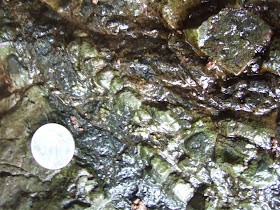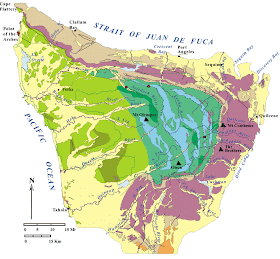I had a little engineering geology project along Hood Canal that had a nice exposure of former ocean floor lava. The lava was a mix of breccia blocks of basalt and pillows. The breccia is from rubble of broken fragments of lava and the pillows are places where the lava pulsed out into the water forming a pillow-like shape. The rubble-like deposits were easy to see. I was rather unsuccessful at capturing any pillow pictures - the exposure, light and contrast has to be just right.
Crescent Formation lava
Glassy rim of pillow
The lava is part of the Crescent Formation, a broad and thick lava unit that was mostly an undersea formation. Not dissimilar to the sea floor lavas that erupt from ocean spreading centers off the Washington and Oregon coasts today. However, the amount of magma in the Crescent was so great some of it flowed out above sea level - perhaps something like Iceland toady. For some reason the spreading ridge magma that formed the Crescent, like Iceland, got an extra surge of magma. One idea is it was augmented by a nearby hot spot magma plume.
This former Ocean floor has been accreted to the edge of North America. It has since been folded and bent as more ocean floor sediments have been stacked up and thrust under the Crescent. The Crescent forms a crescent shaped outcrop pattern on geologic maps, but its name is derived fro Crescent Bay along the shore of the Strait of Juan de Fuca.
Olympic Peninsula geologic map (USGS)
Crescent Formation is the purple unit.
Greenish units are younger slices of ocean floor sediments thrust under and against the older Crescent



My first time to your blog and I thoroughly enjoyed it. We just backpacked along the Quilcene for a week and had lots of discussions about the Crescent Formation. We observed these breccia ( like the big rock at Bark Shanty) and debated the basalt nature vs sediment. My wife appreciates your summary so she can discuss it in her classroom. Nice job, thank you for sharing your knowledge.
ReplyDelete